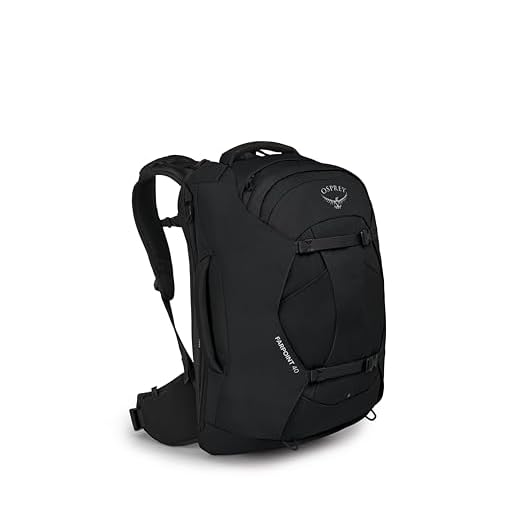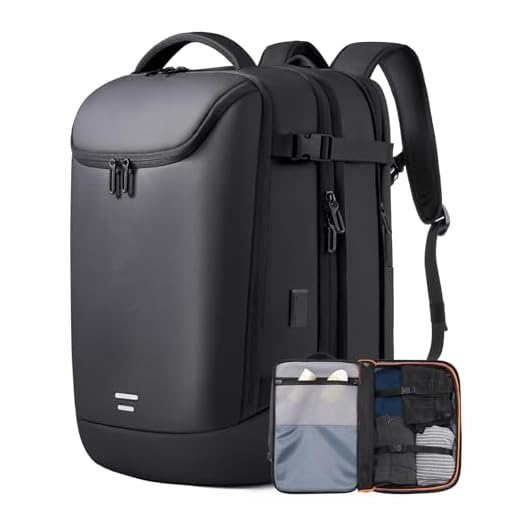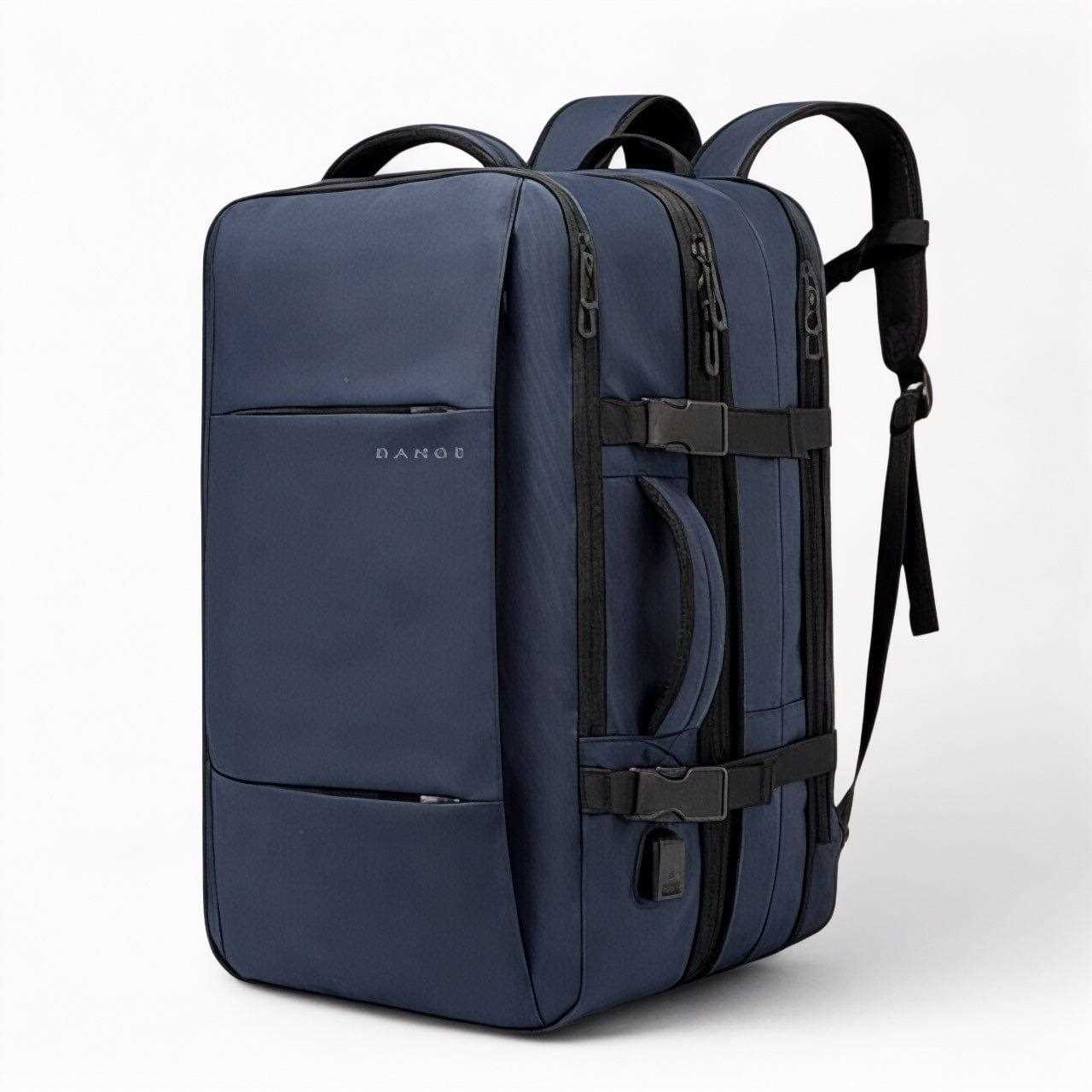




My first recommendation is the Osprey Farpoint 40. This pack combines ample space with a lightweight design, making it ideal for remote work while on the go. It features a laptop compartment, multiple pockets, and a comfortable harness system that adapts to various body types.
This article aims to guide you through the most suitable options available for those who frequently move from one location to another while managing their professional responsibilities. You’ll find detailed reviews and comparisons of several models that cater to different preferences and budgets.
By the end, you’ll have a clearer understanding of what to look for in a reliable carrier, such as durability, organization, and comfort. Whether you’re a freelancer or a full-time traveler, the information here will help you make an informed choice that enhances your mobility and productivity.
Best Travel Backpack for Digital Nomads
Selecting the ideal bag hinges on several key features that cater to a mobile lifestyle. Prioritize a lightweight design, as it ensures comfort during long hours of wear. A well-padded back panel and adjustable shoulder straps significantly enhance the experience, providing support and alleviating strain.
Durability is paramount; choose materials that withstand wear and tear. Water-resistant fabrics protect belongings from unexpected weather changes. Multiple compartments allow for organized storage, making it easy to access tech gadgets, clothing, and personal items quickly.
Key Features to Consider
- Size: Dimensions should comply with airline carry-on regulations, ensuring hassle-free boarding.
- Security: Anti-theft features, such as lockable zippers, safeguard valuable electronics.
- Accessibility: Front-loading designs offer easier packing and unpacking compared to top-loading options.
- Comfort: Look for a sternum strap and a hip belt to distribute weight more evenly.
In terms of tech storage, a dedicated padded laptop compartment is crucial. Ensure it fits your device snugly to prevent damage. Additional pockets for chargers, cables, and other accessories are beneficial for maintaining organization.
Consider how the bag integrates with other gear. Compatibility with packing cubes or organization systems can streamline the packing process. A stylish design also contributes to professional appearance, especially during meetings or networking events.
Ultimately, a well-chosen bag enhances productivity and comfort, allowing for a seamless transition between work and leisure activities.
Essential Features to Look for in a Backpack for Remote Workers
A suitable pack should prioritize organization, allowing easy access to devices and essential items. Look for compartments specifically designed for laptops, tablets, and cables, ensuring everything has its place and is readily available during your adventures.
Additionally, comfort during extended use is crucial. Adjustable straps, padded back panels, and breathable materials can significantly enhance the carrying experience. A lightweight design will also contribute to ease of transport, especially when navigating through busy environments.
Key Aspects to Consider
- Durability: High-quality materials such as water-resistant fabric can protect your gear from unexpected weather while ensuring longevity.
- Security: Look for anti-theft features like lockable zippers and hidden pockets to safeguard your valuables.
- Size and Capacity: Opt for a versatile capacity that complies with airline carry-on regulations, allowing flexibility for both short trips and longer excursions.
- Accessibility: Side access zippers or front-loading designs facilitate quick retrieval of items without the need to unpack the entire bag.
Investing in a pack with these features will streamline your work and exploration, making it easier to adapt to different environments while staying organized and comfortable.
Brands That Cater to Remote Workers’ Needs
Choosing reliable brands that cater to the unique requirements of remote professionals is crucial for enhancing productivity while on the move. Quality craftsmanship, thoughtful features, and organizational capabilities are key factors that set these brands apart.
Many manufacturers focus on creating versatile solutions that combine comfort with practicality. Look for options that provide ample storage, easy access to tech compartments, and durability to withstand various environments.
Key Features to Consider
- Comfortable Straps: Look for ergonomic designs that distribute weight evenly.
- Tech-Friendly Compartments: Padded sections for laptops and tablets are essential.
- Durable Materials: Water-resistant fabrics and robust zippers ensure longevity.
- Organization: Multiple pockets and compartments help keep essentials neatly arranged.
- Security Features: Anti-theft designs, such as lockable zippers, enhance safety.
Choosing the right brand can enhance the experience of working remotely, allowing for smooth transitions between different locations. Consider these factors to ensure that your selection is aligned with your work habits and travel preferences.
Comparative Analysis of Size and Weight: Finding the Right Fit
Choosing the appropriate dimensions and weight of a carry bag is fundamental for those constantly on the move. An ideal pack should balance capacity with portability, ensuring comfort during prolonged use.
When assessing size, consider the volume in liters. Packs usually range from 20 to 50 liters, catering to varying needs. A smaller volume may suffice for short trips or minimalists, while larger options accommodate extended stays or additional gear.
Weight Considerations
Weight plays a significant role in comfort and usability. A lighter pack reduces strain on the body, especially during long walks or commutes. Aim for a bag that weighs less than 1.5 kg when empty to maintain agility.
Material choice impacts both weight and durability. Fabrics like nylon and polyester are common due to their lightweight properties and resistance to wear. Ensure the chosen material withstands diverse environments, from urban settings to rugged terrains.
| Size (Liters) | Ideal Use | Weight (kg) |
|---|---|---|
| 20-30 | Short trips, minimal packing | 0.5 – 1.0 |
| 30-40 | Weekend getaways, moderate packing | 1.0 – 1.5 |
| 40-50 | Extended travel, extra gear | 1.5 – 2.0 |
Ultimately, the right fit harmonizes size and weight, matching personal needs and travel style. Frequent users should prioritize a blend of comfort and functionality while ensuring ease of transport.
Storage Solutions: Organizing Tech Gear and Personal Items
Utilizing compartments and pockets effectively can transform how one manages belongings during travels. Choose a pack that offers multiple sections to segregate tech gadgets from personal items, ensuring quick access and minimizing the risk of damage.
Consider pouches and organizers that fit snugly within your bag. These can hold chargers, cables, and small electronics, preventing tangling and facilitating easy retrieval. Mesh pockets are particularly useful for visibility, allowing you to quickly locate items.
Effective Organization Techniques
Implementing a systematic approach to packing can enhance efficiency. Here are some methods to consider:
- Rolling Clothes: This method saves space and reduces wrinkles.
- Layering: Group similar items together, such as electronics, toiletries, and clothing.
- Utilizing Compression Bags: These can maximize space and keep clothes organized.
For tech gear, investing in a tech organizer can keep all devices in one place. Look for options with customizable sections to fit various sizes of gadgets.
Furthermore, labeling compartments can significantly streamline the process when searching for specific items. Use tags or color-coded stickers for a quick visual guide.
Finally, prioritize accessibility. Place frequently used items in easily reachable pockets, while stowing away less essential gear in deeper sections. This strategy not only enhances convenience but also minimizes disruption during transitions.
Durability and Weather Resistance: Choosing the Right Materials
When selecting a bag for extended use, durability and weather resistance are paramount. Look for materials that can withstand rough handling and various environmental conditions. High-denier fabrics such as nylon or polyester often provide the necessary strength and resistance to tearing.
Additionally, consider options with water-resistant coatings or treatments. This feature is crucial for protecting electronic devices and personal items from unexpected rain or spills. Fabrics with a water-repellent finish can offer extra protection while maintaining breathability.
Material Types
- Nylon: Known for its strength and lightweight properties, nylon is a popular choice. It can be treated for water resistance, making it suitable for different climates.
- Polyester: Offering good durability and UV resistance, polyester is often more affordable and can also be treated for weatherproofing.
- Cordura: A type of nylon known for its durability, often used in high-wear areas due to its abrasion resistance.
- Canvas: A traditional option that is heavy-duty and can be treated for water resistance. However, it may be heavier than synthetic alternatives.
Additional features to consider include reinforced stitching and quality zippers, which enhance the overall durability of the pack. Ensure the seams are double-stitched or taped for added protection against moisture ingress.
Investing in a bag made from high-quality materials not only extends its lifespan but also ensures reliable performance in various weather conditions. The right choice will keep your belongings safe and secure, allowing for a worry-free experience.
Budget Considerations: Best Value Packs for Nomads
For those seeking practicality without overspending, several affordable options stand out. Brands like Osprey, Patagonia, and North Face offer reliable models that blend quality with reasonable pricing. Aim for options in the range of $100 to $200, which typically provide durability and functionality.
When evaluating different models, consider the following features that enhance value:
- Durability: Look for ripstop fabric and reinforced stitching.
- Weight: A lighter pack can make a significant difference during long travels.
- Water Resistance: Essential for protection against unexpected weather.
- Compartments: Multiple pockets for organization can save time and effort.
- Comfort: Padded straps and back panels reduce fatigue.
Here’s a brief comparison of some notable choices:
| Model | Price | Weight | Capacity | Water Resistance |
|---|---|---|---|---|
| Osprey Daylite Plus | $130 | 0.5 kg | 20L | Yes |
| Patagonia Black Hole Pack | $179 | 0.75 kg | 25L | Yes |
| North Face Borealis | $99 | 0.7 kg | 28L | No |
Choosing a reliable companion at a reasonable price enhances the travel experience. Prioritizing durability, comfort, and organization will lead to a satisfying purchase, ensuring that the selected model meets your lifestyle needs without breaking the bank.
Best travel backpack for digital nomads
Features
| Part Number | 10003320 |
| Model | 10003320 |
| Warranty | All Mighty Guarantee |
| Color | Black |
| Is Adult Product | |
| Release Date | 2022-08-30T00:00:01Z |
| Size | 40L |
Features
| Part Number | A82-F01D-DE |
| Model | T66M1D1 |
| Color | Black |
| Is Adult Product | |
| Size | 40L |
Features
| Part Number | tc712 |
| Model | tc712 |
| Color | Black-50l(5-7days Travel) |
| Is Adult Product | |
| Size | Non-vacuum |
Features
| Part Number | BP03006-14-BK |
| Model | BP03006-14-BK |
| Color | Black |
| Is Adult Product | |
| Size | 20L |
Video:
FAQ:
What features should I look for in a travel backpack designed for digital nomads?
When selecting a travel backpack for digital nomads, consider several key features. First, prioritize comfort with adjustable straps and padding for the back and shoulder areas. Look for a backpack that has a dedicated laptop compartment to protect your device during transit. Durability is also important; choose materials that are water-resistant and can withstand various travel conditions. Organizers and pockets for cables, chargers, and other tech accessories can help keep you organized. Additionally, a lightweight design can make a significant difference during long travels. Lastly, consider the backpack’s size; it should comply with airline carry-on regulations while providing enough space for your essentials.
Are there specific brands that are highly recommended for digital nomad travel backpacks?
Yes, several brands are well-regarded among digital nomads for their travel backpacks. For instance, Osprey offers a range of durable and comfortable options, known for their ergonomic designs and practical features. Nomatic is another popular choice, providing backpacks that are specifically tailored for tech users, with compartments for gadgets and a sleek aesthetic. Patagonia also has a solid reputation for creating eco-friendly backpacks that are both functional and stylish. Additionally, the North Face and Tortuga are often mentioned for their reliable products that combine comfort with functionality. When choosing a brand, consider your specific needs and preferences, as each brand has its own unique strengths.







